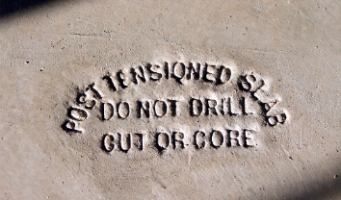Yikes
SAWHORSE
I've seen images of concrete slabs that are stamped with an identification that they are post-tensioned.

I'm wondering if this stamp is a code requirement, or simply best practice.
I'm helping a multifamily client make their podium building ADA accessible, and it involves coring into the concrete deck for new waste lines. The edges of the slab are not visible, so I can't use that as an indicator.
Before we pay for GPR testing: Would the absence of a PT slab stamp be a relatively safe indicator that the slab is not post-tensioned?

I'm wondering if this stamp is a code requirement, or simply best practice.
I'm helping a multifamily client make their podium building ADA accessible, and it involves coring into the concrete deck for new waste lines. The edges of the slab are not visible, so I can't use that as an indicator.
Before we pay for GPR testing: Would the absence of a PT slab stamp be a relatively safe indicator that the slab is not post-tensioned?
